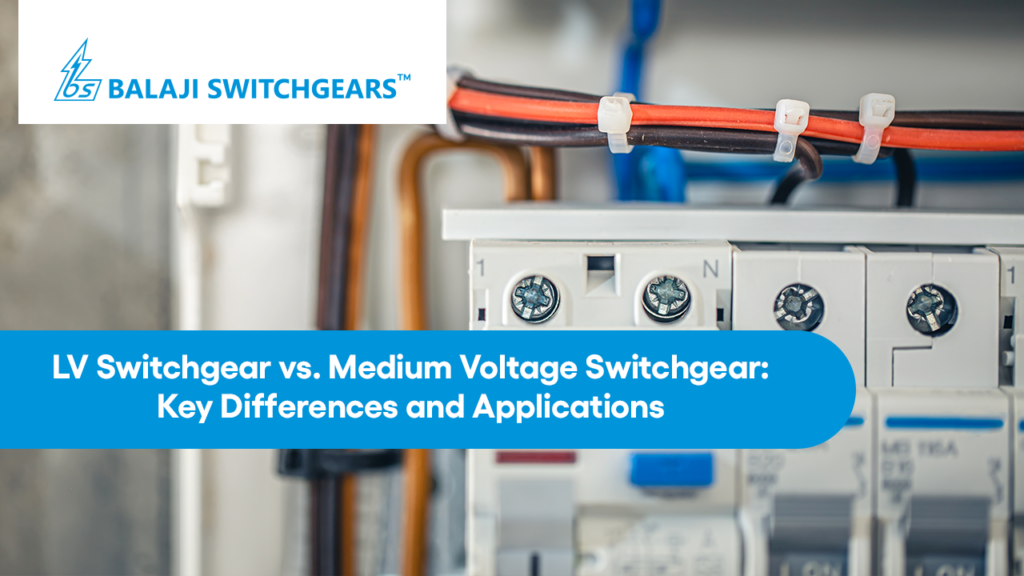Switchgear plays a vital role in ensuring electrical power’s safe and efficient distribution. Understanding the differences between low-voltage (LV) and medium-voltage (MV) switchgear is crucial for selecting the right solution for specific applications. In this blog, we’ll explore their distinctions, features, and applications to help businesses and industries make informed decisions.
What is LV Switchgear?
Low voltage switchgear, commonly referred to as LV switchgear, is designed for systems operating at voltages up to 1,000 volts (1 kV). It is commonly used in residential, commercial, and light industrial applications. LV switchgear includes components like circuit breakers, fuses, contactors, and switches to ensure the protection and control of electrical systems.
Key Features of LV Switchgear:
- Voltage Range: Operates at low voltages, typically up to 1 kV.
- Compact Design: LV switchgear is smaller and more compact compared to medium voltage switchgear.
- Ease of Maintenance: Components are modular, making inspection and maintenance straightforward.
- Safety Measures: Features like arc fault protection and automatic disconnection enhance safety.
What is Medium Voltage Switchgear?
Medium voltage switchgear is designed for systems operating between 1 kV and 36 kV. It is used in industrial, utility, and large commercial setups where power distribution involves higher voltages. This type of switchgear plays a critical role in maintaining the reliability and stability of electrical grids and large industrial systems.
Key Features of Medium Voltage Switchgear:
- Voltage Range: Operates between 1 kV and 36 kV.
- Advanced Protection: Incorporates protection relays and control devices for enhanced system reliability.
- Durable Design: Built to withstand demanding industrial and outdoor environments.
- Automation Capabilities: Often integrated with SCADA systems for remote monitoring and control.
| Key Differences Between LV Switchgear and MV Switchgear |
| Feature | LV Switchgear | Medium Voltage switchgears |
| Voltage Range | Up to 1 kV | 1 kV to 36 kV |
| Applications | Residential, small industries, commercial | Utilities, large sectors, substations |
| Size and Design | Compact and lightweight | Larger and more robust |
| Cost | Relatively low cost | Higher initial investment |
| Maintenance | Simple and less frequent | Requires specialized personnel |
| Automation | Limited automation features | Advanced automation capabilities |
Applications of LV Switchgear
Low voltage switchgear is widely used in environments where electrical loads are lower, such as:
- Residential Buildings: Ensuring safe power distribution in homes and small apartments.
- Commercial Establishments: Malls, offices, and retail spaces benefit from compact and reliable LV switchgear.
- Light Industrial Units: For small-scale machinery and equipment with low power requirements.
- Renewable Energy Systems: Used in solar panel inverters and small wind turbines.
LV switchgear’s cost-effective design and user-friendly maintenance make it ideal for smaller-scale operations.
Applications of Medium Voltage Switchgear
Medium voltage switchgear is essential in environments where higher power distribution is required. Common applications include:
- Power Utilities: Used in substations to regulate and distribute electricity efficiently.
- Heavy Industries: Found in manufacturing plants, mining, and oil refineries where machinery demands higher power.
- Large Commercial Buildings: Airports, hospitals, and shopping complexes depend on medium voltage switchgear for uninterrupted power supply.
- Data Centers: Ensures reliable power distribution to critical IT equipment.
The advanced features of medium voltage switchgear, such as fault detection and remote monitoring, provide a higher level of reliability for industrial systems.
Why Choosing the Right Switchgear Matters
Selecting between LV and medium voltage switchgear is not just a technical decision but also an economic one. The choice should be based on:
- Application Requirements: Understand the power demands of your system.
- Cost Implications: Consider initial investment, maintenance, and operational costs.
- Future Scalability: Choose a system that can adapt to future expansion or technological upgrades.
Balaji Switchgears, a leading name in the industry, offers a comprehensive range of LV switchgear solutions tailored to meet diverse requirements.
Conclusion
Understanding the differences between low voltage switchgear and medium voltage switchgear helps businesses choose the right equipment for their needs. While LV switchgear suits residential, commercial, and small industrial setups, medium voltage switchgear is indispensable for large-scale and high-demand applications.
Partner with Balaji Switchgears for reliable and innovative switchgear solutions. With a commitment to quality and customer satisfaction, Balaji ensures that every product is engineered to enhance efficiency, safety, and performance in power distribution systems.
Contact Balaji Switchgears today to explore their range of LV switchgears and take the first step toward building a robust and efficient electrical infrastructure.


“Absolutely great content! Truly appreciate the effort and creativity you’ve put into this. Keep up the amazing and inspiring work!”
Your writing has a way of resonating with me on a deep level. It’s clear that you put a lot of thought and effort into each piece, and it certainly doesn’t go unnoticed.